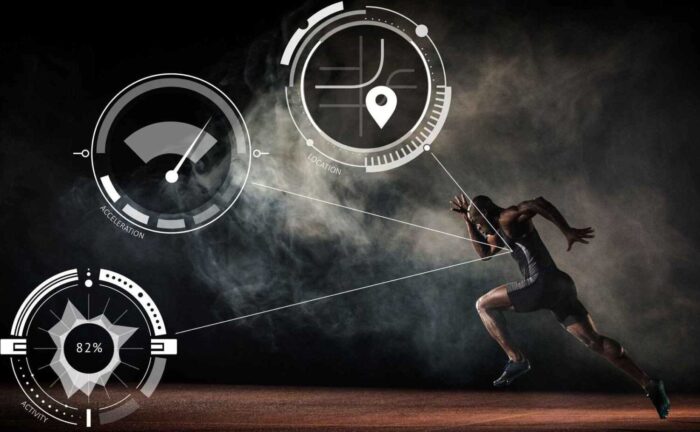Technological innovations have become a game-changer in the fast-paced world of competitive sports. Technology is revolutionizing how we play, watch, and understand sports, from wearable devices that track athlete performance to instant replay systems that ensure fair play.
The fusion of sports and technology has enhanced the fan experience and provided coaches and players with unprecedented tools for training and strategic planning. This convergence promises to propel the sporting industry to new heights, creating a data-rich, performance-driven landscape that is more immersive than ever before.
The Impact of Wearable Technology on Athlete Performance

Fitness trackers and wearable technology have carved a new frontier in sports by providing a wealth of biometric data that radically enhances performance analysis. These devices monitor an athlete’s physiological parameters—heart rate, sweat rate, oxygen levels, and even sleep patterns. Such in-depth analytics enable a tailored approach to each athlete’s training and recovery programs, improving efficiency and reducing the risk of injuries.
Metrics gleaned from wearables guide athletes in maximizing their physical potential and offer coaches a deeper insight into the team’s overall performance.
Enhancing Training Regimes with Wearable Tech
Incorporating wearable tech into training regimes revolutionizes traditional methodologies, allowing for real-time feedback and adjustments. Whether it is a sprinter analyzing stride patterns or a swimmer perfecting stroke efficiency, wearable devices provide immediate data to inform and refine technique.
By consistently tracking progress over time, athletes and coaches can plot a more precise course to peak performance. This technology bridges the gap between the subjective feel of a workout and the objective reality of performance, setting new standards in sports training and athlete development.
Advancements in Sports Viewing Experience

Beyond the field and the gym, technological breakthroughs enhance how fans engage with sports.
How Virtual Reality is Bringing Fans Closer to the Action
The advent of virtual reality (VR) in sports is revolutionizing the spectator experience, providing fans with the sensation of being right in the stadium from the comfort of their homes. VR technology allows viewers to choose their own vantage points, offering an unprecedented level of immersion and interaction.
High-definition and Multi-angle Broadcasts
High-definition VR broadcasts capture the intensity and excitement of live games with stunning clarity. Multi-angle features give fans the freedom to select their viewing perspective, whether it’s center court, behind the goal, or even from the athlete’s point of view. This level of control and quality transforms the act of watching sports into an active rather than passive experience.
The Advent of Augmented Reality in Live Sports
Augmented reality (AR) further enhances live sports by overlaying digital information onto the broadcast. Fans can access player stats, game analytics, and other enriching content in real time without ever looking away from the action. AR is quickly becoming integral to how fans engage with their favorite sports and teams, providing a dynamic and interactive way to process the game as it unfolds.
Integrating live sports and betting platforms like Sportsbook.FanDuel.com adds a new dimension to the viewing experience. Enthusiasts can now place bets in real-time as the action unfolds, drawing them deeper into the game’s excitement.
These platforms blend seamlessly with AR and VR technologies, allowing fans to make informed decisions with all the necessary statistics and data at their fingertips.
Data Analytics in Sport

Data analytics is changing the face of sports strategy by leveraging vast amounts of data to optimize team performance and tactics. Teams are mining complex datasets to uncover insights that can give them a competitive edge. From player recruitment to game-day decisions, analytics is pivotal in informing strategies that capitalize on an opponent’s weaknesses and enhance a team’s strengths.
Through the meticulous study of patterns and statistics, coaches and sports scientists are building strategic approaches that are both evidence-based and highly customized to their team’s unique dynamic.
Esports: The Digital Revolution
Esports, or electronic sports, signify a digital revolution, catapulting competitive gaming into the spotlight of the global sports stage.
These organized, multiplayer video game competitions, widely watched by live audiences and via online platforms, have gained astonishing popularity, particularly within games like ‘League of Legends,’ ‘Dota 2,’ and ‘Overwatch.’ Professional esports athletes compete for prestigious titles and substantial prize pools, often rivaling traditional sports events in scale and fervor.
The esports industry has seen a meteoric rise in audience and revenue, driven by advancements in streaming technology and the proliferation of gaming culture. With its superstars, teams, and legions of fans, esports is continually challenging the preconceived boundaries between physical and digital realms in the competitive sports arena.
The Future of Technology in Sports
As we look to the future, technology in sports is set to evolve in ways that may surpass our current understanding. We can expect to see further integration of AI and machine learning to enhance performance analytics, revolutionize fan interactions, and streamline operational efficiencies.
Biotechnology could lead to advanced injury prevention and personalized nutrition plans tailored to the genetic profiles of athletes. Additionally, the expansion of IoT (Internet of Things) in sports equipment and facilities will lead to smarter and more interactive environments that respond to the needs of athletes and spectators alike.
With these advancements, the line between sports, technology, and entertainment will continue to blur, creating experiences that are more immersive, engaging, and personalized than ever before.
Conclusion
As we reflect on the myriad ways technology has transformed the sporting world, it becomes clear that the interplay between sports and technological innovation is profound and enduring. The convergence of these fields has elevated athletic performance and fan engagement and heralded a new era of digital connectivity in the realm of physical achievement.
The continued advancement of technology promises to disrupt further and enhance the sports industry, eventually reshaping our interactions with and perceptions of sports. It is an evolution that will invariably enrich the human experience, fostering community, competition, and the ceaseless pursuit of excellence.
Frequently Asked Questions

What benefits does wearable technology provide for athletes?
Wearable technology offers athletes real-time feedback on their performance, enabling them to make immediate adjustments and track progress over time.
How is virtual reality changing the way fans experience sports?
Virtual reality immerses fans into the game by providing the sensation of being present in the stadium and the ability to choose unique viewing perspectives.
What role does data analytics play in modern sports strategy?
Data analytics helps teams optimize performance through strategic insights, predicting outcomes, and informing decisions from player recruitment to game-day tactics.
Will esports continue to grow in popularity and be recognized like traditional sports?
Given its current trajectory and mainstream appeal, esports is expected to continue growing and may achieve recognition comparable to traditional sports.

